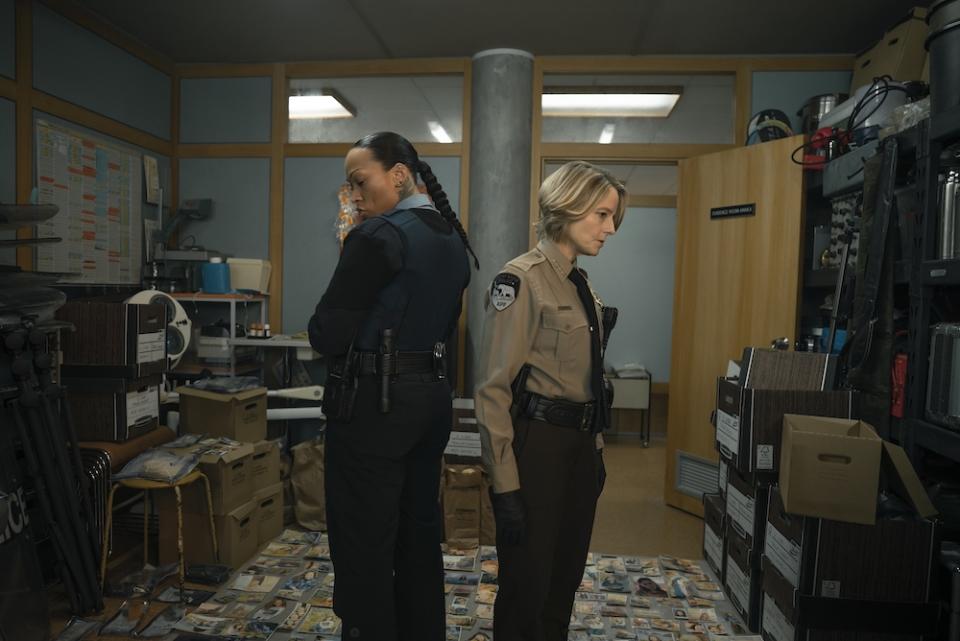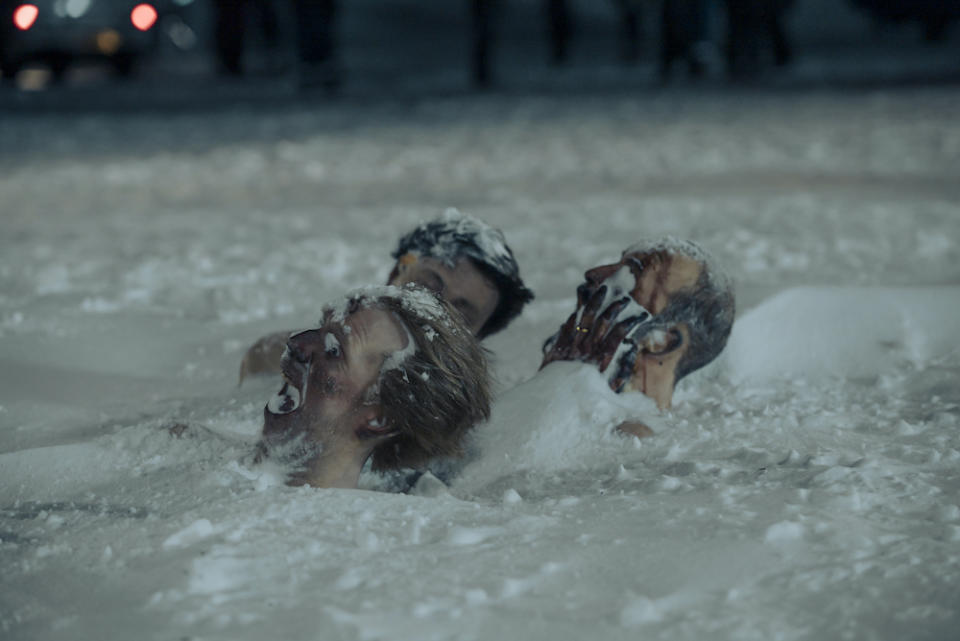Why Does ‘True Detective’ Season 4 Share So Much with Season 1? Jodie Foster and Issa Lopez Explain

- Oops!Something went wrong.Please try again later.
[Editor’s Note: The following article contains light spoilers for “True Detective” Season 4.]
The “corpsicle,” as it’s been dubbed since “Night Country” author Issa López first wrote the scene, is a shocking sight to behold. Twisted naked bodies, frozen in ice, have been carved from their original resting place and plopped at the center of a hockey rink to thaw. How did they die? Why are they naked? Who — or what — did this to them? As the ice melts, secrets spill out and the dead’s last moments gain gruesome clarity. Frostbite blackens their extremities. Teeth marks cover their skin. One is bleeding from the ears. Another is missing the fingers he’d used to claw out his own eyes.
More from IndieWire
Despite its vividly unique rendering, the corpsicle is still strangely familiar. Here are these dead naked men, ornately displayed by natural elements, unable to shield themselves from the discerning eyes of the detectives investigating their demise. You can’t help but stare, and then feel bad for staring. Not only is it grisly, but a bit pitiful, too. The victims of a crime deserve better than to be so crudely exposed, so crassly examined, not just by anyone who wanders into the ice rink, but also by everyone watching at home. Even TV’s dead deserve some civility… don’t they?
The question basically answers itself, once viewers remember the corpsicle is one more grotesque murder tableau (as my colleague Sarah Shachat succinctly described them) in a series that started with a doozie: a dead girl crowned with deer antlers, surrounded by twig sculptures, and bent to kneel in front of a towering old tree. That’s how we met Dora Lange (Amanda Rose Batz) in “True Detective” Season 1, the initial victim assigned to detectives Rust Cohle (Matthew McConaughey) and Marty Hart (Woody Harrelson). Dora is a primary example of a prevalent trope: the Dead Girl Show. From “Twin Peaks” and “Law & Order” to “The Night Of” and “True Detective,” crime dramas repeatedly rely on dead female victims, often naked and abused, to motivate their heroic male leads.
“True Detective: Night Country” reverses that dynamic in ways both expected and singular. Previous prestige cop shows have put women in charge of investigations, just as “Night Country” does here, be it “Top of the Lake,” “The Killing,” “Happy Valley,” “Sharp Objects,” or “Mare of Easttown.” But as part of a franchise, “Night Country” directly confronts its past in a way standalone genre series can only suggest. Season 4 isn’t just connected to Season 1. It’s commenting on it.
“These are women investigating the bodies of men. Those were men investigating the bodies of women,” Issa López, writer and director of “Night Country,” said in an interview with IndieWire. “These are women dealing with their own losses and their own grief — and dealing with the men around them as best they can. So yes, [the corpsicle] was absolutely an intentional inversion.”
“True Detective” Season 4 is filled with clear stylistic allusions and direct narrative connections to the first season of the HBO anthology series. While it’s common these days for franchises to hearken back to their glory days, filling out “cinematic universes” with so many easter eggs the hunt becomes more of a picnic, “True Detective: Night Country” puts a purposeful twist on its nostalgic tie-ins. The references to Season 1 aren’t there to prop up Season 4, but to prove stories don’t have to be told the same way, from the same perspectives, to achieve a similar effect. Who deserves justice, vengeance, and basic civility? What should we, as an audience, expect from our genre stories? How much anger, and how much grace? “Night Country” is its own gripping story, but it’s also an assessment of what “True Detective” was, is, and could be. So it obviously had to start from the beginning.

“There Are a Lot of Little Connections”
“I don’t think I’ve met anybody that didn’t like that first season,” López said. “So I thought about what made Season 1 so unique, what made it memorable, and it was a feeling. People miss that feeling, they crave it, and they wanted to experience it again. You felt that there was something dirty and sinister and crooked. Stuff that was so ugly they wouldn’t show it to you — a sensation that there was a hidden world behind our own.”
“I think it was the sense of place,” Jodie Foster said about the foundational elements of “True Detective” she wanted to preserve in “Night Country.” “How, in Americana, we have these places that are like Mars. That have this weird, timeless, supernatural quality to them, whether it’s the Bayou in Louisiana or Ennis, Alaska. There’s something kind of primordial about that, that feels timeless. It’s so important.”
Prior to Season 4, series creator Nic Pizzolatto was the showrunner on every season. He wrote every episode of the first season, building out the world with the help of Season 1 director Cary Fukunaga. López came into the gig with her own story that she then adapted into a season of “True Detective,” so one of her initial questions for HBO executives was how reflective of the franchise “Night Country” had to be.
“When I got the job, I was like, ‘How close do you want this? Do you really want me to [copy] the old format exactly?’ And they were like, ‘It’s yours. Do whatever: as little or as much as you want.'”
While López jettisoned an early plan to tell Season 4 over split timelines — mirroring the classic interview format from the first season that set up past and present narrative tracks — she held onto plenty of other “True Detective” staples.
“There are a lot of little connections,” she said. “The spiral that in the first season represents Carcosa — which Carcosa in itself is the beyond, the nether regions — in here it represents that, too. I loved those long conversations in the car about the nature of the universe, but it was great in the first one because Cohle is a nihilist and Hart is just a dude. So what was my version of that? One of my characters is a spiritual, and the other one is an skeptic — because that’s me. I’m divided between those two, dancing between those two. I think most of us are.”
A bigger connection was that Travis Cohle, whose ghost guides Rose Aguineau (Fiona Shaw) to the corpsicle of dead scientists, is actually Rust Cohle’s father. “He was a survivalist who died in Alaska,” López said, citing a line from the first season’s finale when McConaughey’s character said his dad moved the family to Alaska when he was a kid (and had “some pretty fucking strange ideas”).
The tie-ins don’t stop there. Season 4 revives Tuttle United, the same company whose influential owners were related to Season 1’s ultimate villain, Erroll Childress (Glenn Fleshler). The freaky little twig sculptures seen in the first season reemerge in Season 4, Episode 2, via Raymond Clark’s secret trailer. More references emerge in the finale (premiering February 18).

Why Season 1 and Season 4 Are ‘Complimentary Pieces’
But for every connection, there’s a twist. “Night Country” balances a healthy appreciation of the world it’s inherited with its own piercing view of those surroundings. While Danvers and Navarro interrogate witnesses, the show around them interrogates itself.
“If you go back and you look at Season 1, it’s sort of an essay on toxic masculinity and the impact that has on these two men’s lives and how they need to change in order to save themselves,” Foster said. “And since it’s from their point of view, there’s a lot of misogyny in there.”
Neither the acknowledgement of male toxicity nor the unacknowledged prejudice against women is hard to find in “True Detective” Season 1. Cohle’s cynicism toward humanity (especially the cruelty of men) and Hart’s reluctance to accept such a dark worldview becomes a recurring push and pull between partners. At the same time, the season itself treats women with a carelessness than could be considered cruel. Thinly sketched wives, lost daughters, sex workers who were little more than props — these were the women of Season 1, and they weren’t exactly dynamic characters. With “Night Country,” there was an opportunity to tackle those flaws head-on.
“It was nice to reimagine [‘True Detective’] from a female point of view — a genuine female point of view, where you have characters that are messy, peculiar, and need each other,” Foster said. “There’s a sort of a weird sisterhood there, where they hate each other but they have each other’s backs and they respect one another. Even their relationships to their sexuality, which are also kind of messed up, were interesting when you revisit the original ‘True Detective’ — it’s a way of seeing what happens when you apply a female gaze to this anthology.”
“I’m not mad at ‘True Detective’ being male because [Nic] Pizzolatto is a guy — it’s appropriate he made a show about the things he believed in and he perceives,” López said. “It is what it is. It’s not dancing around it. It’s about men and the obsessions that torture men, and the interaction and the expectations of men with women. It’s a very interesting, profound look into the male psyche. But it’s been done. So why do it again?”
Instead, López focused on how her story could elicit a similar reaction as the first season. She recognized that people may think they want to see exactly what they saw before, but what they really want is to feel the same way they felt when they saw it.
“I know we all miss that series,” she said, “but we can get the same feeling and emotion by telling a completely different story that you haven’t seen. It will feel like new and it will give you what you crave. Where the other one is sweltering, this one is cold. Where the other one is light, this one is dark. So yes, I think they’re complimentary pieces.”
So far, reactions have been positive. Ratings reflect fans’ enthusiasm for “Night Country,” with the total audience growing each week through Episode 3. As with any mystery, final verdicts will be held until after the finale airs — and the corpsicle’s full significance has been revealed — but those that have seen the ending tend to admire it. Critics were given all six episodes ahead of time, and their reviews have given Season 4 the highest Metacritic rating since, aptly, Season 1.
“There’s something about looking for these scientists, these missing men, these fabulous wise men,” Foster said. “I think it’s really powerful, because it is inverted from the original thing — instead of the dead woman, it’s the dead men — but it all goes back to what the reality is [for Danvers and Navarro.] It all relates back to murdered and disappeared indigenous women that, in our culture, don’t matter enough. And [the deaths] of these scientists sort of opened up a portal of nature’s vengeance in support of those women. I thought that was just a beautiful idea.”
There’s no telling where “True Detective” will go in the future, who will pick up the badges and whose deaths they’ll be working to avenge. But “Night Country” has paved clear path toward a bright future. Just wait ’til the ice melts — and you see how it ends.
“True Detective” Season 4 is available on HBO and Max.
Best of IndieWire
Where to Watch This Week's New Movies, Including 'Argylle' and 'How to Have Sex'
Christopher Nolan's Favorite Movies: 40 Films the Director Wants You to See
Sign up for Indiewire's Newsletter. For the latest news, follow us on Facebook, Twitter, and Instagram.

